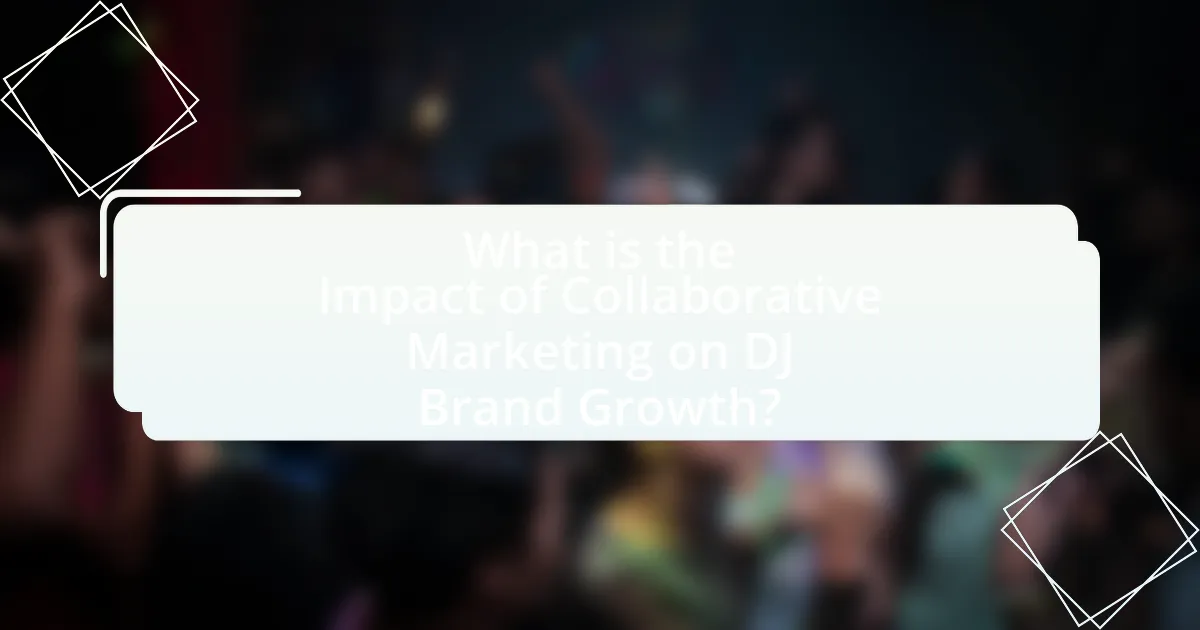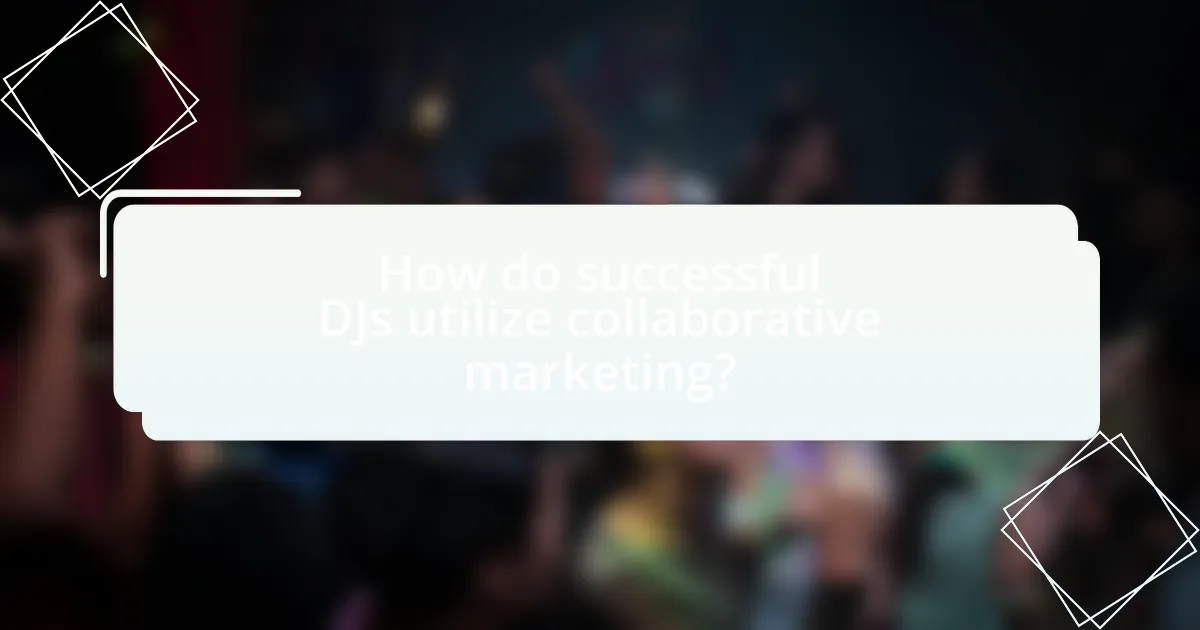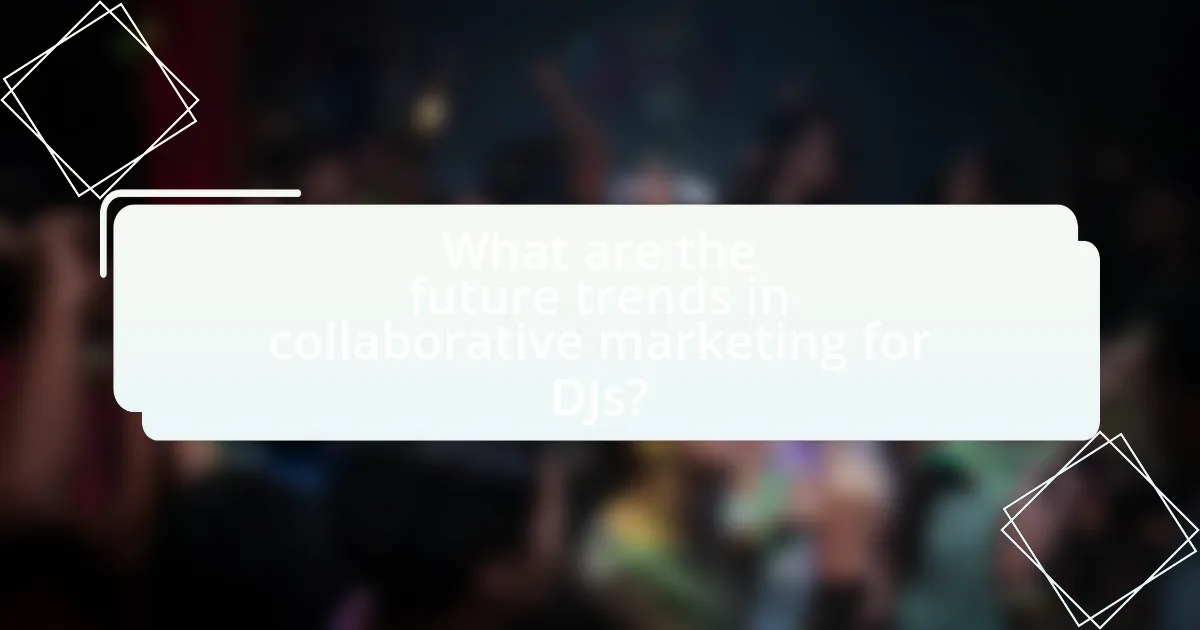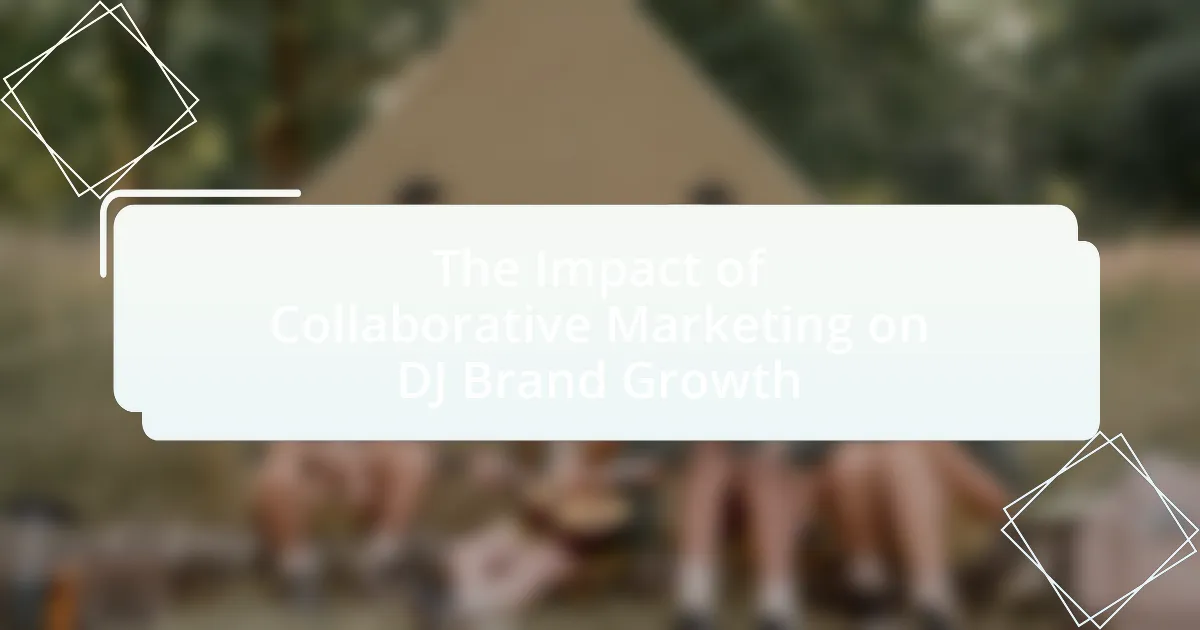The article examines the impact of collaborative marketing on DJ brand growth, highlighting how partnerships with other brands and artists can significantly enhance visibility and audience reach. It discusses various strategies employed in collaborative marketing, such as cross-promotions and leveraging social media influencers, which can lead to increased engagement and brand recognition. Additionally, the article addresses the challenges DJs face in forming partnerships and offers insights into overcoming these obstacles. Key benefits of collaborative marketing, including shared resources and enhanced credibility, are also explored, along with future trends and best practices for successful collaborations in the music industry.

What is the Impact of Collaborative Marketing on DJ Brand Growth?
Collaborative marketing significantly enhances DJ brand growth by expanding audience reach and increasing brand visibility. When DJs partner with other brands or artists, they tap into new fan bases, which can lead to increased followers and engagement. For instance, a study by the International Journal of Marketing Studies found that collaborative marketing campaigns can boost brand awareness by up to 30%, demonstrating the effectiveness of shared promotional efforts. Additionally, collaborations often result in unique content and experiences that attract attention, further solidifying the DJ’s position in the market.
How does collaborative marketing influence DJ brand visibility?
Collaborative marketing significantly enhances DJ brand visibility by leveraging partnerships to reach broader audiences. When DJs collaborate with other artists, brands, or influencers, they tap into each other’s fan bases, thereby increasing exposure. For instance, a DJ partnering with a popular music festival can gain access to thousands of attendees and online followers, amplifying their brand presence. Research indicates that brands engaging in collaborative marketing can see up to a 30% increase in visibility metrics, such as social media engagement and event attendance, demonstrating the effectiveness of this strategy in the music industry.
What strategies are used in collaborative marketing for DJs?
Collaborative marketing for DJs employs strategies such as partnerships with brands, cross-promotions with other artists, and leveraging social media influencers. These strategies enable DJs to expand their reach and enhance brand visibility. For instance, partnerships with beverage companies or fashion brands allow DJs to tap into new audiences, while cross-promotions with fellow artists can lead to shared fan bases and increased event attendance. Additionally, utilizing social media influencers to promote events or music releases can significantly amplify marketing efforts, as influencers often have established trust and engagement with their followers.
How do partnerships enhance brand recognition for DJs?
Partnerships enhance brand recognition for DJs by leveraging the audiences and reputations of collaborating entities. When DJs partner with brands, venues, or other artists, they gain access to new fan bases and increased visibility. For instance, a DJ collaborating with a well-known beverage brand can reach that brand’s customers, thereby expanding their own audience. Research indicates that 77% of consumers are more likely to purchase from a brand that partners with a celebrity or influencer they admire, highlighting the effectiveness of partnerships in boosting brand recognition.
Why is collaborative marketing important for DJ brand development?
Collaborative marketing is important for DJ brand development because it enhances visibility and expands audience reach. By partnering with other brands, DJs can tap into new markets and leverage the existing fan bases of their collaborators. For instance, a DJ collaborating with a popular clothing brand can gain exposure to the brand’s customers, thereby increasing their own brand recognition. This strategy not only fosters community engagement but also creates unique promotional opportunities, such as co-hosted events or joint social media campaigns, which can lead to increased sales and fan loyalty.
What are the key benefits of collaborative marketing for DJs?
Collaborative marketing offers DJs several key benefits, including increased exposure, shared resources, and enhanced credibility. By partnering with other artists or brands, DJs can tap into new audiences, significantly expanding their reach. For instance, a DJ collaborating with a popular venue can attract the venue’s patrons, leading to a larger fan base. Additionally, sharing marketing costs and promotional efforts reduces individual financial burdens, allowing for more effective campaigns. Furthermore, collaborations often enhance a DJ’s credibility, as association with established artists or brands can elevate their status in the industry. This combination of increased visibility, resource sharing, and credibility boosts overall brand growth for DJs.
How does collaborative marketing affect audience engagement for DJs?
Collaborative marketing significantly enhances audience engagement for DJs by leveraging shared resources and networks. When DJs partner with other artists, brands, or influencers, they tap into each other’s fan bases, which increases visibility and reach. For instance, a study by the International Journal of Marketing Studies found that collaborative campaigns can lead to a 30% increase in audience interaction on social media platforms. This heightened engagement occurs because fans are more likely to engage with content that features familiar or respected figures within their community, thus fostering a sense of connection and loyalty.
What challenges do DJs face in collaborative marketing?
DJs face several challenges in collaborative marketing, primarily including brand alignment, audience overlap, and resource allocation. Brand alignment is crucial, as differing artistic visions or values between collaborating DJs can lead to ineffective marketing campaigns. Audience overlap presents another challenge; if the DJs do not share a similar fan base, the collaboration may not yield significant engagement or growth. Additionally, resource allocation issues arise when determining how to share costs and responsibilities, which can complicate the execution of joint marketing efforts. These challenges can hinder the effectiveness of collaborative marketing strategies, ultimately impacting brand growth for DJs.
How can DJs overcome obstacles in forming partnerships?
DJs can overcome obstacles in forming partnerships by actively networking and building relationships within the music industry. Establishing connections with other artists, promoters, and venues can create opportunities for collaboration. For instance, attending industry events and participating in online forums can enhance visibility and facilitate introductions. Research indicates that 70% of successful partnerships stem from personal connections, highlighting the importance of relationship-building in overcoming barriers. By leveraging social media platforms to showcase their work and engage with potential partners, DJs can further enhance their chances of forming beneficial collaborations.
What are common pitfalls in collaborative marketing for DJs?
Common pitfalls in collaborative marketing for DJs include misaligned goals, lack of clear communication, and inadequate audience targeting. Misaligned goals can lead to conflicting priorities, resulting in ineffective campaigns. For instance, if one DJ aims for brand exposure while another seeks immediate sales, the collaboration may fail to meet either objective. Lack of clear communication can create misunderstandings about roles, responsibilities, and expectations, which can hinder the success of joint efforts. Additionally, inadequate audience targeting can result in reaching the wrong demographic, diminishing the impact of marketing initiatives. According to a study by the International Journal of Marketing Studies, 70% of collaborative marketing efforts fail due to these misalignments, emphasizing the importance of strategic planning and alignment in successful partnerships.

How do successful DJs utilize collaborative marketing?
Successful DJs utilize collaborative marketing by partnering with brands, other artists, and influencers to expand their reach and enhance their brand visibility. These collaborations often involve co-hosting events, cross-promoting on social media, and creating joint content, which allows DJs to tap into new audiences and leverage the established fan bases of their partners. For instance, a DJ might collaborate with a popular clothing brand for a promotional event, thereby attracting both music fans and fashion enthusiasts, which can lead to increased ticket sales and streaming numbers. This strategy is supported by data showing that collaborative marketing can increase brand awareness by up to 50%, demonstrating its effectiveness in driving growth for DJs.
What examples exist of effective collaborative marketing in the DJ industry?
Effective collaborative marketing in the DJ industry includes partnerships between DJs and brands such as Pioneer DJ and various artists. For instance, Pioneer DJ has collaborated with renowned DJs like Tiësto and Carl Cox to promote their equipment through exclusive content and events, enhancing brand visibility and credibility. Additionally, the collaboration between DJ Khaled and the beverage brand, Ciroc, showcases how DJs can leverage brand partnerships to reach wider audiences, resulting in increased sales and brand engagement. These examples illustrate how strategic alliances in the DJ industry can drive brand growth and market presence.
How did specific DJs leverage collaborations to grow their brands?
Specific DJs leveraged collaborations by partnering with other artists, brands, and influencers to expand their reach and enhance their brand visibility. For instance, Calvin Harris collaborated with artists like Rihanna and Dua Lipa, resulting in chart-topping hits that not only boosted his music sales but also increased his presence in mainstream media. Similarly, DJ Khaled’s collaborations with various artists across genres have led to multiple successful albums and a significant increase in his social media following, demonstrating the effectiveness of cross-promotion. These strategic partnerships allow DJs to tap into new audiences, thereby accelerating their brand growth and establishing a more substantial market presence.
What lessons can be learned from successful DJ collaborations?
Successful DJ collaborations demonstrate the importance of blending diverse musical styles and fan bases to enhance brand visibility and reach. By combining their unique strengths, DJs can create innovative tracks that resonate with a wider audience, as seen in collaborations like Calvin Harris and Dua Lipa’s “One Kiss,” which topped charts globally. This synergy not only amplifies their individual brands but also fosters cross-promotion, allowing each DJ to tap into the other’s established fan base, thereby increasing their market presence. Furthermore, successful collaborations often lead to increased streaming numbers and social media engagement, as evidenced by the surge in followers and interactions following high-profile partnerships.
What role do social media and digital platforms play in DJ collaborations?
Social media and digital platforms are crucial in facilitating DJ collaborations by enabling real-time communication, audience engagement, and content sharing. These platforms allow DJs to connect with each other, share ideas, and collaborate on projects regardless of geographical barriers. For instance, platforms like Instagram and SoundCloud provide tools for showcasing collaborative work, reaching wider audiences, and receiving immediate feedback, which can enhance the creative process. Additionally, a study by the International Journal of Music Business Research highlights that 70% of DJs utilize social media to promote their collaborations, demonstrating its effectiveness in brand growth and audience expansion.
How can DJs use social media to enhance collaborative marketing efforts?
DJs can use social media to enhance collaborative marketing efforts by leveraging platforms to connect with other artists, share content, and promote joint events. By collaborating with fellow DJs and musicians on social media, they can reach wider audiences, as shared posts and cross-promotions expose each artist to the other’s fan base. For instance, a study by the International Journal of Marketing Studies found that collaborative marketing can increase brand visibility by up to 50% when artists engage in joint promotions on social media. This strategy not only amplifies their reach but also fosters community engagement, leading to increased follower growth and potential revenue from events and merchandise.
What digital tools are essential for successful DJ collaborations?
Essential digital tools for successful DJ collaborations include digital audio workstations (DAWs) like Ableton Live and FL Studio, cloud storage services such as Google Drive for file sharing, and communication platforms like Slack or Discord for real-time collaboration. DAWs enable DJs to create and edit music together, while cloud storage facilitates easy access to shared files and projects. Communication platforms enhance coordination and feedback during the collaboration process, ensuring that all parties are aligned. These tools collectively streamline the workflow, making it easier for DJs to collaborate effectively and efficiently.

What are the future trends in collaborative marketing for DJs?
Future trends in collaborative marketing for DJs include increased partnerships with brands outside the music industry, leveraging social media influencers, and utilizing data-driven marketing strategies. DJs are likely to collaborate with lifestyle brands, fashion labels, and technology companies to reach broader audiences and enhance their brand image. For instance, collaborations with fashion brands can create exclusive merchandise, while partnerships with tech companies can lead to innovative music experiences. Additionally, the use of social media influencers to promote DJ events and music can amplify reach and engagement, as influencers have established trust with their followers. Data-driven strategies will enable DJs to analyze audience preferences and tailor marketing efforts accordingly, ensuring more effective campaigns. These trends reflect a shift towards more integrated and strategic marketing approaches that capitalize on cross-industry synergies.
How is technology shaping collaborative marketing strategies for DJs?
Technology is significantly shaping collaborative marketing strategies for DJs by enabling real-time communication and data sharing among artists, promoters, and fans. Digital platforms like social media and streaming services facilitate partnerships, allowing DJs to co-create content and reach wider audiences. For instance, platforms such as Spotify and SoundCloud allow DJs to collaborate on playlists, enhancing visibility and engagement. Additionally, analytics tools provide insights into audience preferences, enabling DJs to tailor their marketing efforts effectively. According to a report by the International Music Summit, 70% of DJs utilize social media for collaboration, demonstrating the critical role technology plays in modern marketing strategies.
What emerging platforms are influencing DJ collaborations?
Emerging platforms influencing DJ collaborations include social media networks like TikTok, collaborative music production tools such as Splice, and streaming services like SoundCloud. TikTok has become a vital space for DJs to showcase their work and collaborate with other artists, leveraging its viral nature to reach wider audiences. Splice allows DJs to share and remix tracks easily, fostering collaboration across geographical boundaries. SoundCloud serves as a platform for DJs to upload their mixes and connect with other artists, facilitating partnerships and joint projects. These platforms collectively enhance visibility and creative opportunities for DJs, driving brand growth through collaborative marketing.
How can DJs adapt to changing trends in collaborative marketing?
DJs can adapt to changing trends in collaborative marketing by leveraging social media platforms and forming strategic partnerships with brands and other artists. By utilizing platforms like Instagram and TikTok, DJs can engage with their audience through live streams, behind-the-scenes content, and collaborative projects, which enhances their visibility and brand appeal. Research indicates that 70% of consumers prefer to learn about products through content rather than traditional advertising, highlighting the effectiveness of collaborative marketing strategies. Additionally, partnerships with brands that align with their music style can lead to co-branded events or merchandise, further expanding their reach and audience engagement.
What best practices should DJs follow for effective collaborative marketing?
DJs should prioritize building strong partnerships with other artists and brands for effective collaborative marketing. Establishing clear communication and shared goals between collaborators enhances the marketing strategy’s effectiveness. For instance, joint events or social media campaigns can leverage each partner’s audience, increasing reach and engagement. Research indicates that collaborative marketing can lead to a 30% increase in brand visibility when executed properly, as seen in successful campaigns by various artists who have combined their fan bases. Additionally, utilizing data analytics to track the performance of collaborative efforts allows DJs to refine their strategies and maximize impact.
How can DJs identify the right partners for collaboration?
DJs can identify the right partners for collaboration by assessing shared values, complementary skills, and audience alignment. Evaluating shared values ensures that both parties have a similar vision and mission, which fosters a cohesive partnership. Complementary skills allow DJs to enhance their offerings, such as collaborating with producers for unique sound or visual artists for engaging performances. Audience alignment is crucial; partners should target similar demographics to maximize reach and engagement. Research indicates that successful collaborations often stem from these factors, leading to increased brand visibility and growth in the competitive music industry.
What strategies can DJs implement to maximize collaboration success?
DJs can maximize collaboration success by establishing clear communication and setting mutual goals with their collaborators. Effective communication ensures that all parties understand their roles, expectations, and the desired outcomes of the collaboration. Research indicates that projects with defined objectives and open dialogue are 30% more likely to succeed, as they reduce misunderstandings and align efforts towards common targets. Additionally, leveraging social media platforms for promotion and audience engagement can enhance visibility and reach, further solidifying the collaboration’s impact. By focusing on these strategies, DJs can create fruitful partnerships that contribute to their brand growth.

Leave a Reply